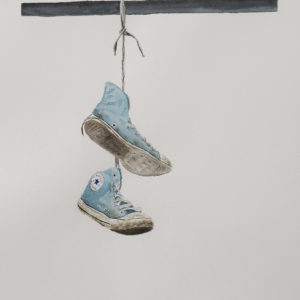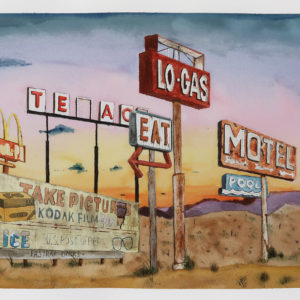Description
Finding Solace in Art: Jay Samit’s Moving Watercolors
BY KAMI GAHIGA
Based in Los Angeles, Jay Samit is an American artist and author. Having spent a career creating innovative technology to bring art, music, and video to billions on the Internet, Samit’s art is heavily influenced by the impact endless change has on humans and our institutions. An international bestselling author, Samit is considered the world’s leading authority on disruption. His book, Disrupt You!, is presently published in 8 languages. Jay Samit paints predominantly in a regionalist style with subjects inspired by American street scenes and landscapes, captured in a variety of moods and defined by a moving interplay of light and subtle hues. His most recent series, created during the corona virus quarantine, is a moving record of the artist’s emotional response to our current era. Jay Samit presents a tantalizing array of visually arresting and emotionally engaging works on paper. Millions of people in the world are facing a period of isolation due to the corona virus pandemic. Staying away from loved ones proves to be a challenge to many. Jay Samit’s paintings could not be more significant today and yet they possess an enduring quality. Each of the artist’s painting transcends narrative illustration and invites its viewer to project his own experiences into his colorful scenes.
In Route 66 Motel, a looming motel stands alone in a semi-abandoned landscape. The painting radiates with empathy felt through its subdued composition. A pale green roof reveals blemishes and degradation accentuated by hues of umber and rust, speaking to the passing of time. Fotomat exhibits a freestanding drive-through photo development kiosk in an empty parking lot. Rendered obsolete by the gradual rise of the digital camera and smartphone – most of these authentic kiosks have been abandoned or demolished. Route 66 Motel and Fotomat share an uncanny charm and harbor a Hopperesque appeal, once beloved by American society and quickly forgotten with the advent of technology. But they are not sad, instead they lessen the feeling that we are alone in our experience of solitude.
Although, not all quarantine experiences can be put on the same scale, this could not be better illustrated than in the alienated figures of Samit’s gripping Unhappy Amazon and Empty Shelves paintings, which epitomize the disproportionate effects of the pandemic on the most vulnerable. Empty Shelves radiates an emphatic understanding and creates visual tension accentuated by Samit’s contrast of a largely white background punctuated by red. There, an old lady with her head bent forward hunched over her unfilled cart, roams in front of empty grocery shelves. Unhappy Amazon also shines an unflinching spotlight on the downside of digital globalization.
Ghost bench and Basketball Ghost illustrate scenes we recognize as sites of sociability but are portrayed in an austere manner. Richly worked in shades of blue, Basketball Ghost is a tauntingly beautiful painting and a testament to Samit’s gift in capturing moods and emotions. Shadows are recurrent motifs in his works and suggest a sense of melancholy from days gone by. Yet, Basketball Ghost balances its darker tones with an almost equal amount of white space, creating a sense of lightness in contrast and ultimately revealing a sense of hope.
His most recent work, There Are Some Things You Can Only Learn in A Storm exhibits a stunning executed cinematic scene of the American cultural archetype: the western. Two cowboys gallop downhill with their horses in deep snow under a vivid blue sky. The contrast of colors and the slanted landscape is a perfect metaphor of both our desire for evasion and a reminder to stay resilient amidst challenging times.
Jay Samit’s masterful combination of soft and powerful brushstrokes create moving pictures that poignantly communicate the melancholy that defines our time in all its loneliness and beauty.






Reviews
There are no reviews yet.